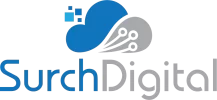In the world of digital marketing, small service-based businesses face a unique challenge: how to reach high-quality leads without overspending on advertising. While platforms like Facebook and Google dominate the conversation, LinkedIn Ads remain one of the most effective tools for connecting with professionals, business owners, and decision-makers — the people who often need your services most.
At Surch Digital, we specialize in helping small service-based businesses leverage LinkedIn Ads to generate leads, build authority, and grow revenue. In this guide, we’ll walk through why LinkedIn Ads are valuable for small businesses, how to get started, and strategies to maximize your results in 2025.
Why LinkedIn Ads Are Valuable for Service-Based Businesses
LinkedIn is the largest professional networking platform in the world, with over 900 million members spanning industries and job functions. For small businesses offering services like landscaping, home improvement, consulting, or professional services, LinkedIn Ads provide a way to reach decision-makers directly.
Here’s why LinkedIn Ads are a powerful tool for service-based businesses:
- Targeted Audience: LinkedIn allows hyper-specific targeting based on industry, job title, company size, location, skills, and more.
- High-Intent Leads: Users on LinkedIn are often actively researching business solutions, making them more likely to convert.
- Professional Context: LinkedIn’s professional environment encourages engagement with B2B services and premium offerings.
- Brand Authority: Consistent LinkedIn campaigns build trust and credibility with business audiences.
By advertising on LinkedIn, small service-based businesses can bypass mass audiences and focus on high-quality prospects who are more likely to convert.
Understanding LinkedIn Ad Types
Before launching your campaign, it’s important to understand the different types of LinkedIn Ads available:
1. Sponsored Content
Sponsored Content appears directly in the LinkedIn feed, similar to a native post. You can use it to:
- Share blog posts, case studies, or educational content
- Promote special offers or services
- Drive traffic to your website or landing page
This format works well for building awareness and engagement, especially when paired with valuable content.
2. Sponsored Messaging (Message Ads)
Message Ads are sent directly to LinkedIn users’ inboxes. They are highly personal and effective for:
- Offering free consultations
- Sending event invitations or webinars
- Reaching decision-makers directly
Personalized messages often see higher engagement rates than traditional email marketing.
3. Text Ads
Text Ads appear on the sidebar or top of LinkedIn pages. They are simple, cost-effective, and great for driving traffic to landing pages or promoting offers with clear CTAs.
4. Dynamic Ads
Dynamic Ads automatically personalize visuals based on the viewer’s profile. For example, you can include the user’s photo or company name to create a more personalized, engaging experience.
Choosing the right ad type depends on your marketing goals, audience, and budget.
Step 1: Define Your Goals
Every successful LinkedIn Ads campaign starts with a clear goal. Common goals for small service-based businesses include:
- Generating high-quality leads
- Driving traffic to your website or landing page
- Promoting a webinar or consultation
- Building brand awareness in a specific region
Defining your goal helps determine ad type, targeting, messaging, and budget, ensuring your campaign is aligned with your business objectives.
Step 2: Target the Right Audience
LinkedIn’s strength is its precise targeting capabilities. Small service-based businesses can narrow their audience based on:
- Industry: Focus on specific sectors that need your services. For example, a digital marketing agency might target healthcare or home services businesses.
- Job Title: Reach decision-makers such as owners, managers, or department heads.
- Company Size: Tailor your campaigns to small businesses, mid-sized companies, or enterprise clients.
- Location: Target specific cities, regions, or ZIP codes to capture local leads.
- Skills or Interests: Reach users with skills relevant to your service offerings.
By honing in on the right audience, you increase your chances of getting meaningful leads rather than low-quality clicks.
Step 3: Craft Compelling Ad Copy
Your ad copy should grab attention, clearly communicate value, and include a strong call-to-action (CTA). Key tips for creating effective LinkedIn Ads copy:
- Highlight Benefits, Not Just Features: Explain how your service solves a problem or improves the customer’s life. For example, “Increase your customer base with expert landscaping marketing services.”
- Use Clear, Action-Oriented CTAs: Examples include “Schedule Your Free Consultation,” “Download Our Guide,” or “Get Started Today.”
- Include Social Proof: Mention client success stories, reviews, or industry awards to build credibility.
- Keep It Professional: LinkedIn is a professional platform, so maintain a tone that reflects your brand authority.
Strong ad copy paired with attention-grabbing visuals significantly improves click-through rates and conversions.
Step 4: Design Engaging Visuals
Visuals are crucial for LinkedIn Ads. Consider these tips:
- Use high-quality images or graphics relevant to your service.
- Include branding elements like logos, colors, and fonts for consistency.
- Test carousel ads to showcase multiple services or client projects.
- Keep visuals clean and professional — avoid clutter.
In 2025, eye-catching, professional visuals can help your ads stand out in a busy LinkedIn feed and reinforce your messaging.
Step 5: Set Your Budget and Bidding Strategy
LinkedIn Ads operate on a cost-per-click (CPC) or cost-per-impression (CPM) basis. For small service-based businesses:
- Start with a modest daily budget to test performance
- Use automated bidding initially to optimize for clicks or conversions
- Monitor spend and adjust based on results
LinkedIn Ads can be more expensive than other platforms, but the quality of leads often justifies the investment.
Step 6: Test, Measure, and Optimize
Testing and optimization are key to LinkedIn Ads success. Track important metrics like:
- Click-through rate (CTR)
- Conversion rate on landing pages
- Cost per lead (CPL)
- Engagement with sponsored content
A/B test headlines, visuals, messaging, and CTAs to determine what resonates most with your audience. Regularly review results and refine campaigns for maximum ROI.
Advanced LinkedIn Strategies for Small Businesses
Once you’re comfortable with basic campaigns, you can explore advanced strategies:
- Retargeting Campaigns: Re-engage users who visited your website or engaged with your content but didn’t convert.
- Lookalike Audiences: Target users similar to your best customers to expand your reach.
- Content Marketing Integration: Use LinkedIn Ads to promote blog posts, case studies, or videos that establish authority and nurture leads.
- Lead Gen Forms: LinkedIn offers pre-filled lead forms that reduce friction and increase lead capture rates.
By combining advanced targeting with high-quality content, small service-based businesses can generate leads consistently while building brand credibility.
Examples of Service-Based Businesses Succeeding on LinkedIn
Small service-based businesses across industries have seen measurable success with LinkedIn Ads:
- Consulting Firms: Targeting executives and managers in specific industries to book strategy sessions.
- Home Services: Reaching property managers, real estate agents, and business owners for contracts and service agreements.
- Healthcare Practices: Promoting webinars or health programs to decision-makers in companies or local organizations.
By tailoring campaigns to specific industries and decision-makers, LinkedIn Ads deliver high-quality, ready-to-convert leads.
Conclusion
LinkedIn Ads offer a unique opportunity for small service-based businesses to reach decision-makers, generate high-quality leads, and grow revenue. Unlike broader platforms, LinkedIn provides precise targeting, professional engagement, and access to audiences that matter most to your business.
To succeed in 2025, businesses should:
- Define clear marketing goals
- Target the right audience with precision
- Craft compelling ad copy and professional visuals
- Set realistic budgets and monitor performance
- Test, optimize, and scale campaigns for ROI
- Explore advanced strategies like retargeting, lookalike audiences, and lead gen forms
At Surch Digital, we specialize in helping small service-based businesses navigate the complexities of LinkedIn Ads and other digital marketing strategies. From audience targeting and ad creation to campaign optimization and analytics, our team ensures that every dollar spent drives measurable results.
If your small business is ready to start generating high-quality leads with LinkedIn Ads, contact Surch Digital today. With the right strategy and expert guidance, LinkedIn can become a powerful engine for growth, helping your business reach decision-makers and convert leads into loyal clients.




